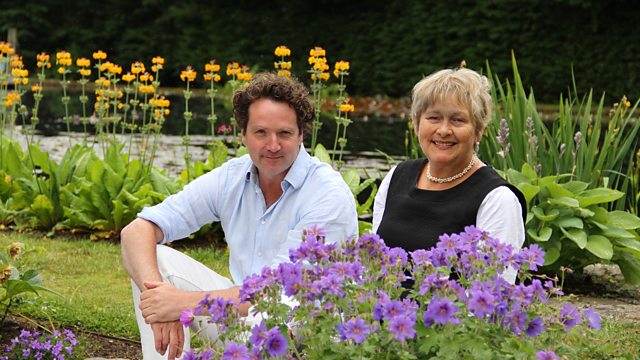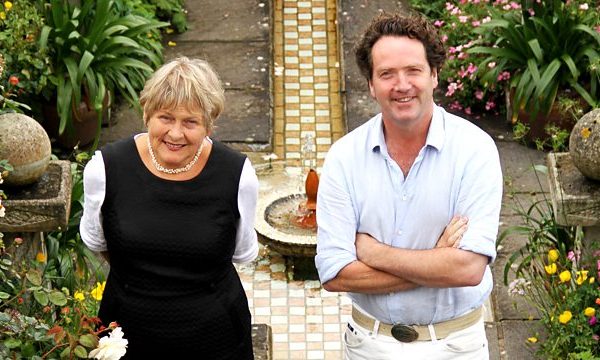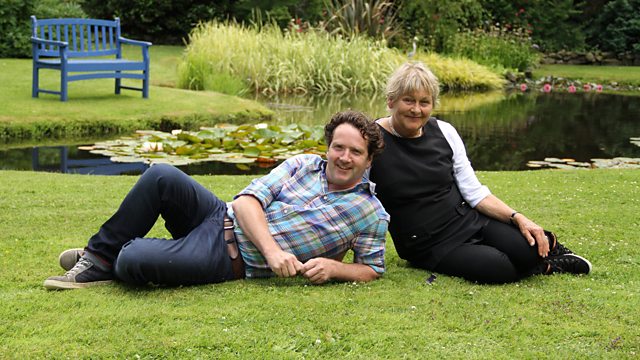Wild About Your Garden episode 1: In the inaugural episode of “Wild About Your Garden,” we journey to a quaint, typical backyard in Crayford, Kent. This garden, much like countless others, features a neatly-trimmed lawn bordered by slender flowerbeds. It’s the beloved sanctuary of Betty, a charming lady who’s puzzled by the absence of butterflies in her garden. Despite her efforts in setting up bird feeders, she’s yet to welcome any avian visitors. Her longing for wildlife has led her to create an assembly of plastic animals, a silent testament to her unfulfilled desire for nature’s company.
Enter the dynamic trio: the energetic Nick Knowles, renowned garden designer Chris Beardshaw, and wildlife enthusiast Ellie Harrison. The team from “Wild About Your Garden” embarks on a transformative journey to infuse life into Betty’s garden. This is no ordinary makeover; it’s a challenge of revitalizing nature itself. The crew delves into a laborious task, removing over ten tons of concrete and decorative paving. Their efforts pave the way for the planting of a diverse array of flora, including 14 fully-grown trees, with one weighing as much as two cars!
Amidst this garden revolution, Ellie Harrison identifies a unique opportunity to aid a species in peril: the water vole, Britain’s most endangered mammal. Convincing Betty might be a hurdle, given her misconception of these creatures as rat-like. However, the team is determined to not only transform Betty’s garden into a wildlife haven but also to enlighten her about the beauty and importance of all creatures in the ecosystem.
The episode promises an inspiring blend of garden transformation and wildlife conservation, with a touch of heartwarming human interaction.
Wild About Your Garden episode 1: Setting the Scene for a Garden Transformation
Discovering Betty’s Garden: A Crayford Gem
In the heart of Crayford, Kent, lies a garden that mirrors the dreams of many – a neatly-trimmed emerald lawn, hugged by slender, flower-laden borders. This serene oasis belongs to Betty, whose love for her garden radiates in every carefully pruned petal and blade of grass. Yet, amidst this picture-perfect setting, there’s a silent yearning for a splash of vibrant wildlife, an echo of nature’s symphony that seems to have faded away.
Betty’s garden, while visually stunning, whispers tales of missing butterflies and birds, a common narrative in urban gardens today. It stands as a microcosm of a larger environmental concern, subtly highlighting the impact of urbanization on local ecosystems. The absence of fluttering wings and chirping melodies doesn’t just diminish the garden’s charm; it reflects a deeper disconnect between urban spaces and the wildlife they once hosted.
Betty’s Quest for Nature’s Company
Betty, with a heart as warm as the summer sun, tried bridging this gap. Bird feeders stand in hopeful anticipation, yet remain untouched, as if the birds have forgotten this once-frequented haven. In a touching display of longing, Betty has adorned her garden with a menagerie of plastic animals. These silent, unblinking creatures serve as placeholders for the living, breathing wildlife she yearns to see.
Her efforts and desires paint a poignant picture of modern gardening struggles. It’s not just about cultivating plants, but about rekindling a lost connection with nature. Betty’s story isn’t unique; it resonates with many who seek to bring life back into their gardens. It’s a tale of hope and determination, a narrative that sets the stage for a remarkable journey of transformation. A journey that seeks not only to rejuvenate a garden but to revive the soul of the ecosystem it represents.
The Wild About Your Garden Team: Heroes of Habitat Restoration
Meet the Trio: Nick Knowles, Chris Beardshaw, and Ellie Harrison
In the quest to revive Betty’s garden, a trio of garden and wildlife experts steps in, each bringing a unique flair and expertise. Leading the charge is Nick Knowles, a man whose energy and passion for garden makeovers are as boundless as the gardens he transforms. He’s the catalyst, turning garden dreams into lush, vibrant realities.
Then there’s Chris Beardshaw, an award-winning garden designer whose knowledge of plants and design principles turns ordinary spaces into extraordinary havens. Chris’s ability to blend aesthetics with functionality is nothing short of magical. His designs don’t just look good; they breathe life into every corner of the garden.
Rounding out the team is Ellie Harrison, a wildlife enthusiast whose love for nature is contagious. Her insights into wildlife habitats and conservation are vital in ensuring that the garden is not just a feast for human eyes, but a sanctuary for local fauna. Ellie’s expertise is crucial in making the garden a buzzing, chirping, fluttering hub of biodiversity.
The Challenge of Reviving Betty’s Garden
The task at hand is monumental. The team faces the challenge of removing over ten tons of concrete and paving, remnants of a bygone era of garden design. This isn’t just a physical endeavor; it’s symbolic, representing the shedding of the old to make way for the new.
In place of the cold, hard concrete, the team plans to introduce a diverse array of flora. Imagine 14 fully-grown trees being planted, with one having the heft of two cars! This is more than gardening; it’s a revival of nature. Each plant, each tree, is carefully chosen not only for its aesthetic appeal but for its role in the ecosystem.
The transformation is not just about beautification; it’s about bringing balance back to an urban space. It’s a mission to create a harmonious coexistence between humans and nature, where every bloom, every leaf, plays a part in restoring the garden’s ecological integrity.
Beyond Beautification: A Mission for Wildlife Conservation
Introducing the Water Vole: Britain’s Endangered Mammal
In the midst of transforming Betty’s garden, a pivotal moment arises with the discovery of the water vole, a creature teetering on the brink of extinction in Britain. This small mammal, often mistaken for a rat, plays a crucial role in the health of our aquatic ecosystems. Ellie Harrison, with her deep-rooted passion for wildlife, brings to light the plight of these voles.
The garden’s makeover takes on a new dimension as the team contemplates integrating habitats for these endangered voles. It’s not just about aesthetics anymore; it’s about creating a haven for wildlife, a sanctuary where endangered species can thrive. This chapter isn’t just about gardening; it’s a tale of conservation, of giving back to nature what urbanization has taken away. The presence of the water vole serves as a poignant reminder of the fragile balance between human spaces and wildlife habitats.
Balancing Aesthetics with Ecology
Transforming Betty’s garden now involves a delicate balance between beauty and biodiversity. Chris Beardshaw’s expertise becomes invaluable as he designs a garden that’s not only a visual delight but also an ecological stronghold. The team carefully selects plants that are not only appealing to the human eye but also beneficial to local wildlife, including the water vole.
This endeavor transforms the garden into a microcosm of the local ecosystem, a place where beauty and nature coexist harmoniously. The team’s efforts symbolize a larger movement, a call to action for gardeners everywhere to consider the impact of their green spaces on local wildlife. By the end of this chapter, Betty’s garden is no longer just a picturesque retreat; it’s a beacon of hope for conservation, a testament to the possibility of coexistence between human beauty and nature’s needs.
Frequently Asked Questions – Wild About Your Garden episode 1
What are the key steps to transforming a garden into a wildlife sanctuary?
Transforming a garden into a wildlife sanctuary starts with understanding the local ecosystem. Choose native plants that provide natural food sources and shelter for local wildlife. Incorporating water features, like a small pond, can attract a variety of species. Additionally, minimize the use of chemicals and pesticides to ensure a safe habitat for all creatures.
How can typical urban gardens attract more birds and butterflies?
Attracting birds and butterflies to urban gardens involves planting native flowering plants, shrubs, and trees that provide nectar, seeds, and fruits. Installing bird feeders and birdbaths can also create a welcoming environment. Remember, diverse plant species not only add beauty but also cater to the different needs of various bird and butterfly species.
Why is the water vole endangered, and how can gardeners help?
The water vole is endangered primarily due to habitat loss, pollution, and predation by invasive species like the American mink. Gardeners can help by creating habitats that mimic their natural environment, such as ponds with gentle, vegetated banks. Avoiding the use of harmful chemicals and maintaining a natural balance in the garden also supports their survival.
What challenges do garden makeover shows face when balancing aesthetics with ecological needs?
Garden makeover shows often face the challenge of creating visually appealing gardens that are also sustainable and wildlife-friendly. They must balance aesthetic elements like design and symmetry with ecological considerations like plant diversity and habitat creation. The key is to harmonize visual appeal with the functionality of a living ecosystem.
Conclusion Wild About Your Garden episode 1
The journey through Betty’s garden transformation is more than just a tale of turning a space green. It’s a narrative that intertwines the delicate threads of nature with the fabric of community and personal well-being. The metamorphosis of this Crayford garden is a microcosm of a larger, more profound ecological and social change.
The Ecological Renaissance
The transformation of Betty’s garden into a wildlife sanctuary has far-reaching implications. Each plant, each tree, each water feature, serves not just as an aesthetic element but as a vital component of a thriving ecosystem. The resurgence of butterflies, the chirping of birds, and the presence of the water vole are testaments to what can be achieved when we harmonize our living spaces with nature. This garden has become a beacon of hope, demonstrating the power of thoughtful, ecologically-minded gardening.
Strengthening Community Bonds
Betty’s garden makeover journey has done more than just rejuvenate the land; it has sown the seeds of community spirit. Neighbors, inspired by the transformation, are more inclined to start their own gardening projects, creating a ripple effect of green spaces throughout the community. This shared goal of nurturing nature fosters a stronger, more connected community, united by a common purpose and a shared love for the environment.
In conclusion, the revitalization of Betty’s garden is a poignant reminder of the impact we can have on our environment and community. It’s a story of hope, showing that even the smallest spaces can become sanctuaries for wildlife and a source of joy for communities. As we close this chapter, let’s carry forward the message it imparts – that in nurturing our gardens, we nurture our planet and each other.





What a great show! Thanks for posting it, I’d never see it otherwise.
I was really impressed that they actually followed up on the gardens.